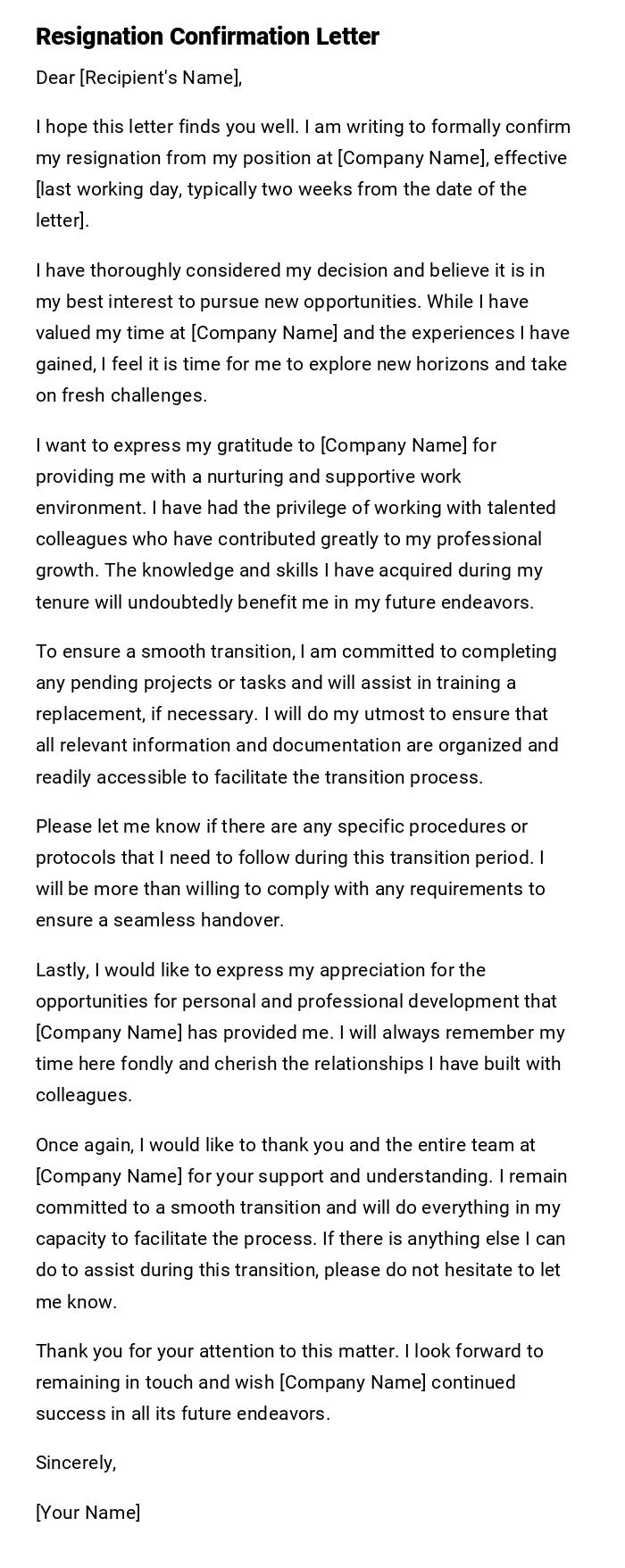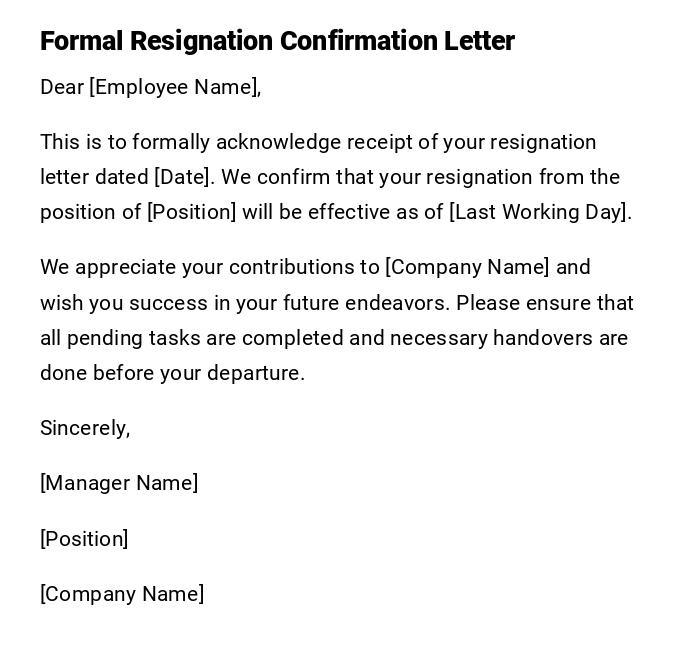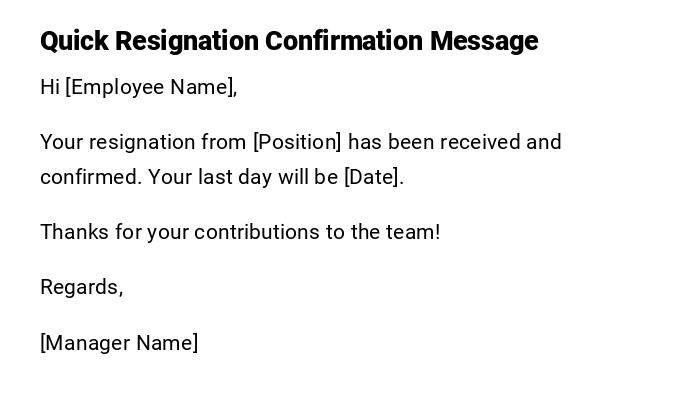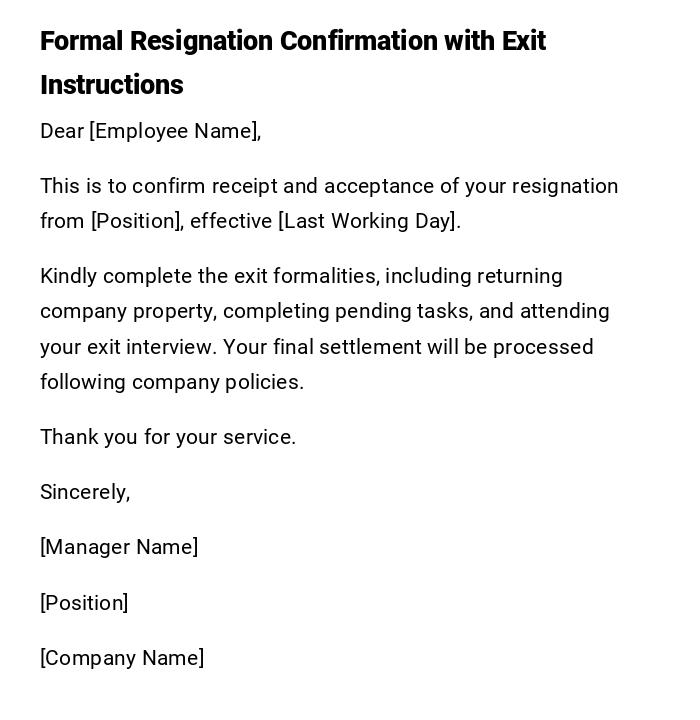Resignation Confirmation Letter
Dear [Recipient's Name],
I hope this letter finds you well. I am writing to formally confirm my resignation from my position at [Company Name], effective [last working day, typically two weeks from the date of the letter].
I have thoroughly considered my decision and believe it is in my best interest to pursue new opportunities. While I have valued my time at [Company Name] and the experiences I have gained, I feel it is time for me to explore new horizons and take on fresh challenges.
I want to express my gratitude to [Company Name] for providing me with a nurturing and supportive work environment. I have had the privilege of working with talented colleagues who have contributed greatly to my professional growth. The knowledge and skills I have acquired during my tenure will undoubtedly benefit me in my future endeavors.
To ensure a smooth transition, I am committed to completing any pending projects or tasks and will assist in training a replacement, if necessary. I will do my utmost to ensure that all relevant information and documentation are organized and readily accessible to facilitate the transition process.
Please let me know if there are any specific procedures or protocols that I need to follow during this transition period. I will be more than willing to comply with any requirements to ensure a seamless handover.
Lastly, I would like to express my appreciation for the opportunities for personal and professional development that [Company Name] has provided me. I will always remember my time here fondly and cherish the relationships I have built with colleagues.
Once again, I would like to thank you and the entire team at [Company Name] for your support and understanding. I remain committed to a smooth transition and will do everything in my capacity to facilitate the process. If there is anything else I can do to assist during this transition, please do not hesitate to let me know.
Thank you for your attention to this matter. I look forward to remaining in touch and wish [Company Name] continued success in all its future endeavors.
Sincerely,
[Your Name]
Formal Resignation Confirmation Letter
Dear [Employee Name],
This is to formally acknowledge receipt of your resignation letter dated [Date]. We confirm that your resignation from the position of [Position] will be effective as of [Last Working Day].
We appreciate your contributions to [Company Name] and wish you success in your future endeavors. Please ensure that all pending tasks are completed and necessary handovers are done before your departure.
Sincerely,
[Manager Name]
[Position]
[Company Name]
Resignation Acceptance Email
Subject: Confirmation of Resignation
Hello [Employee Name],
We have received your resignation submitted on [Date], and this email serves to confirm its acceptance. Your last working day will be [Date].
Thank you for your service at [Company Name]. We wish you all the best in your future endeavors.
Best regards,
[Manager Name]
[Position]
Quick Resignation Confirmation Message
Hi [Employee Name],
Your resignation from [Position] has been received and confirmed. Your last day will be [Date].
Thanks for your contributions to the team!
Regards,
[Manager Name]
Heartfelt Resignation Confirmation Letter
Dear [Employee Name],
We acknowledge your resignation letter dated [Date] with mixed emotions. Your dedication and hard work at [Company Name] have been truly appreciated.
Your resignation will be effective as of [Last Working Day]. We wish you nothing but success and happiness in your future endeavors. You will always remain part of our extended family.
Warm regards,
[Manager Name]
[Position]
Formal Resignation Confirmation with Exit Instructions
Dear [Employee Name],
This is to confirm receipt and acceptance of your resignation from [Position], effective [Last Working Day].
Kindly complete the exit formalities, including returning company property, completing pending tasks, and attending your exit interview. Your final settlement will be processed following company policies.
Thank you for your service.
Sincerely,
[Manager Name]
[Position]
[Company Name]
Provisional Resignation Confirmation Letter
Dear [Employee Name],
We have received your resignation submitted on [Date]. This letter serves as a provisional confirmation, pending completion of the notice period and exit formalities.
Your tentative last working day is [Date], subject to the completion of all pending responsibilities. We appreciate your contributions during your tenure with [Company Name].
Sincerely,
[Manager Name]
What / Why You Need a Resignation Confirmation Letter
- Confirms that an employer has received and accepted the employee's resignation.
- Provides a formal acknowledgment that outlines the last working day and any necessary exit procedures.
- Ensures clarity and reduces potential misunderstandings between employee and employer.
Who Should Send a Resignation Confirmation Letter
- Immediate supervisors or managers.
- Human resources department.
- Authorized personnel responsible for employee record management.
Whom Should a Resignation Confirmation Letter Be Addressed To
- The employee who submitted the resignation.
- In some cases, copied to HR or departmental heads for documentation purposes.
When to Send a Resignation Confirmation Letter
- Immediately after receiving the employee’s resignation letter or email.
- Before the notice period begins, to confirm acceptance and timeline.
- When outlining exit formalities and last working day details.
Requirements and Prerequisites Before Sending
- Employee’s official resignation letter or email.
- Employee’s designation and department.
- Last working day and notice period details.
- Any company-specific exit procedures or formalities.
How to Write a Resignation Confirmation Letter
- Begin with a polite greeting addressing the employee.
- Acknowledge receipt of the resignation and confirm its acceptance.
- Clearly state the last working day and any exit procedures required.
- Include appreciation for contributions and well wishes for the future.
- End with a formal closing and authorized signature.
Formatting Guidelines for Resignation Confirmation Letters
- Length: 1–3 paragraphs depending on details.
- Tone: Formal, professional, and courteous; can be warm or heartfelt for valued employees.
- Mode: Email for quick acknowledgment; printed letter for official records.
- Wording: Clear and concise, avoid ambiguity regarding last working day or exit procedures.
After Sending / Follow-up Steps
- Ensure the employee receives and acknowledges the letter.
- Coordinate with HR to process exit formalities and final settlement.
- Maintain a copy in the employee’s HR file for record-keeping.
Tricks and Tips for Effective Resignation Confirmation
- Use templates to ensure consistency in tone and format.
- Include all necessary details like last working day and exit instructions.
- Keep the tone professional but adaptable based on the employee’s tenure and relationship.
Common Mistakes to Avoid
- Omitting the last working day or notice period information.
- Using an overly casual or ambiguous tone.
- Failing to send the letter promptly after receiving the resignation.
- Forgetting to include necessary instructions for exit procedures.
Elements and Structure of a Resignation Confirmation Letter
- Opening: Greeting and acknowledgment of resignation receipt.
- Body: Confirmation of acceptance, last working day, and any instructions.
- Closing: Appreciation, best wishes, and authorized signature.
- Optional Attachments: Exit process guidelines, final settlement details, or company property checklist.
FAQ About Resignation Confirmation Letters
-
Q: Is it necessary to send a resignation confirmation letter?
A: Yes, it formally acknowledges the resignation and prevents misunderstandings. -
Q: Can a resignation confirmation be sent via email?
A: Yes, emails are commonly used and legally acceptable if clearly documented. -
Q: Should we include exit instructions in the confirmation letter?
A: Including exit instructions helps streamline the process and avoids confusion. -
Q: Can the tone be informal?
A: For long-term or valued employees, a warm or heartfelt tone may be appropriate, but professional tone is recommended overall.








 Download Word Doc
Download Word Doc
 Download PDF
Download PDF